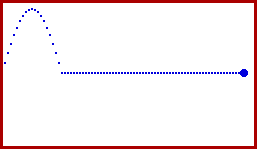
Reflection of a Pulse
at a Fixed End
A GIF Animation
Consider a pulse moving through a medium - perhaps through a
rope, a slinky or even a telephone cord. What happens to the pulse
when it reaches the end of that medium? The answer depends on whether
the medium is fixed in space or free to move at its end. For example,
if the pulse is moving through a rope and the end of the rope is held
firmly by a person, then it could be said that the pulse is
approaching a fixed end. On the other hand, if the end of the rope is
lying on the floor such that it is free to move up or down when the
pulse reaches its end, then it could be said that the pulse is
approaching a free end.
The animation below depicts a pulse moving through a medium which
is fixed at its end.

The animation depicts a behavior which is referred to as
inversion. The pulse becomes inverted upon reflecting off the
fixed end. That is, a pulse with an upward displacement will reflect
off the end and return with a downward displacement. This inversion
behavior will always be observed when the end of the medium is fixed.
This inversion behavior is also observed when the medium is connected
to another more heavy or more dense medium. In the latter case, when
the pulse reaches the end of the medium, a portion of the pulse will
reflect off the end and return with an inverted displacement. The
heavier medium acts like a fixed end to cause the pulse to be
inverted.
In conclusion, a pulse reaching the end of a medium becomes
inverted whenever it either
- reflects off a fixed end,
- or is moving in a less dense medium and reflects off a more
dense medium.
For more information on physical descriptions of waves,
visit
The
Physics Classroom. Specific information is available there on the
following topics:
Other animations can be seen at the
Multimedia
Physics Studios. Other useful resources regarding the physics of
motion and waves is available through the
Glenbrook
South Physics Home Page.
This page was created by
Tom
Henderson of
Glenbrook South
High School.
Comments and suggestions can be sent by e-mail to
Tom
Henderson.
This page last updated on 8/11/98.
